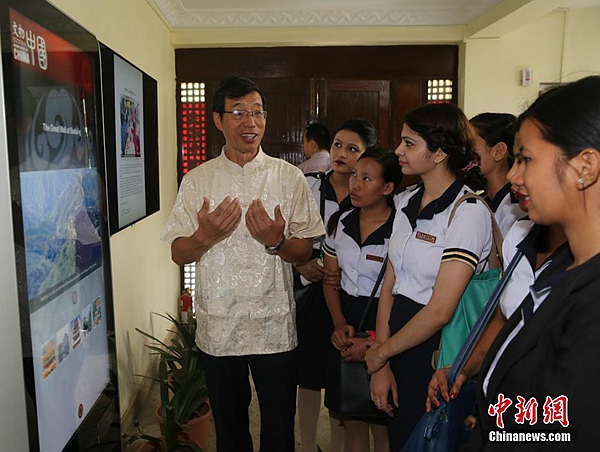Sino-Nepalese ties go from strength to strength
- By Ritu Raj Subedi
 0 Comment(s)
0 Comment(s) Print
Print E-mail China.org.cn, August 4, 2017
E-mail China.org.cn, August 4, 2017
|
|
|
About 30 Nepalese ainline stewardesses visit China Cultural Center based in Kathmandu on August 3, 2017. [Chinanews] |
"China's basic policy of diplomacy with neighboring countries is to treat them as friends and partners, to make them feel secure and to support their development. This policy is characterized by friendship, sincerity, reciprocity and inclusiveness." --Chinese President Xi Jinping
These wise remarks by Chinese President Xi Jinping aptly apply to Nepal-China relations as the two countries marked the 62nd anniversary of the establishment of diplomatic relations on August 1. Sino-Nepalese relations have been marked by a high level of understanding, friendship, sincerity, mutual cooperation and people-to-people bonding.
Formal diplomatic ties began after both nations successfully completed epoch-making revolutions. Nepal had brought an end to the century-old family rule of the Rana oligarchy while China, under Communist Party leadership, carried out the New Democratic Revolution, liberating itself from the yoke of domestic reactionaries and foreign aggressors.
In April 1955, delegations of two nations held talks in Indonesia on the sidelines of the first Afro-Asian conference in Bandung, involving Major General Shovar Jung Thapa and Premier Zhou Enlai.
This was followed by the visit of the Chinese ambassador to India Yuan Zhongxian to Kathmandu. The two sides finally signed an agreement to establish the diplomatic relations on the basis of Panchasheel (the Nepalese word for the five principles of peaceful co-existence first enunciated by Premier Zhou) in Kathmandu on August 1, 1955.
The joint communiqué issued at that time stated: "The two governments believe the establishment of diplomatic relations will also promote further development in cultural and economic cooperation between the two nations."
During Chinese Premier Zhou's visit to Nepal in April 1960, the two countries concluded a Treaty of Peace and Friendship, declaring their respect for each other's independence, sovereignty and territorial integrity, and agreed to settle any disputes through peaceful dialogue.
Chairman Mao Zedong rightly said: "The Sino-Nepalese border should be peaceful and friendly forever." The two nations amicably sorted out their border issues and signed a border treaty in 1961.
This sharply contrasts with Nepal's border disputes with its giant southern neighbor that still encroaches on over 85,000 hectors of Nepalese territory.
King Mahendra, former Prime Minister BP Koirala, Chairman Mao and Premier Zhou are considered the key architects of Sino-Nepalese relations. However, a further significant moment was when paramount leader Deng Xiaoping visited Nepal in 1978 to open a "friendship highway," a visit that led to agreement on the air connectivity between the two nations, and an agreement for China to establish a sugar mill and a paper factory in Nepal.
Deng also promptly supported King Birendra's "Zone of Peace" proposal, an idea that India never liked.
Nepal and China have proved to be all-weather friends, helping each other in the times of crisis. On October 1, 1949, Chairman Mao proudly announced the establishment of the People's Republic of China from the Tiananmen Square, declaring the Chinese people had "stood up" for freedom.
However, the capitalist West was hostile to a communist China. At that moment, Nepal, as a trustworthy friend, constantly demanded restoration of China's legitimate seat in the United Nations. Nepal co-sponsored the resolution to induct China as a full UN member in October 1971.
Nepal has unwaveringly adhered to a "One China Policy" and never allowed its territory to be used against China. As a reliable friend, Nepal quickly disarmed and punished the Khampa rebels hell-bent on destabilizing Tibet from Nepal's northern border.
China has extended critical support to Nepal's much-needed infrastructure development. It has built vital roads, industries and buildings, among others. Its cooperation in the field of education and culture is highly recommendable.
During the Indian economic embargo on Nepal in 2015, China came to help, justifying a popular saying that "a friend in need is a friend indeed." It instantly joined rescue and relief operations in Nepal after it was hit by the Gorkha earthquake. During the Indian blockade, it provided gasoline to Nepal free of charge when its supplies from India were halted.
More importantly, the year marked the signing of a landmark trade and transit treaty that promises to lift Nepalese out of abject poverty.
Now China is the largest foreign investor in Nepal. Nepal stands to benefit from its advanced technology, management skills and able human resources. Nepal is now also part of President Xi's signature development project – the Belt and Road Initiative (BRI) – which seeks robust connectivity between Asia, Europe and Africa.
The BRI holds immense promise for Nepal's all-round development through connectivity, trade, economic integration, cultural exchange and people to people ties. As all components of the BRI become operational, Nepal-China relations will also rise to new heights.
Ritu Raj Subedi is an associate editor of The Rising Nepal.
Opinion articles reflect the views of their authors, not necessarily those of China.org.cn.







Go to Forum >>0 Comment(s)